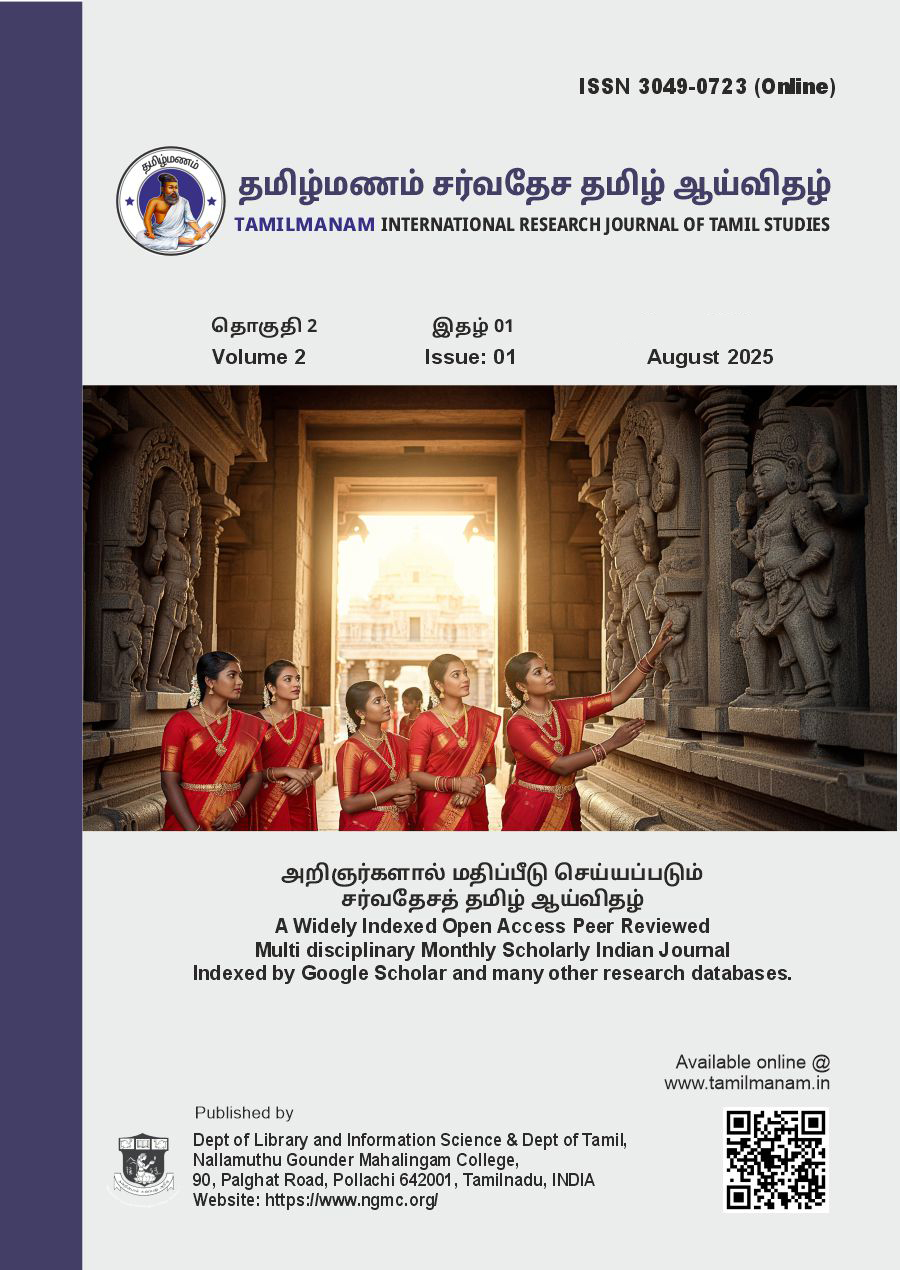குழுமாயி அம்மன் வழிபாட்டில் இசைக்கருவிகளின் பயன்பாடு
The Use of Musical Instruments in Kuzhumayi Amman Worship
DOI:
https://doi.org/10.63300/tm0110012514Keywords:
Kuzhumayi Amman, , WorshipAbstract
The study, "The Use of Musical Instruments in the Worship of Kuzhumayi Amman," explores the cultural significance and use of musical instruments in the worship of the folk deity, Kuzhumayi Amman. It highlights the importance of "material culture studies" in understanding a society's traditions and way of life. The article focuses on three specific instruments: Tharai, Parai and Tamukku or kadinga. The Tharai is a wind instrument made of bronze that is played during the deity's procession and when the deity is placed on and taken off the chariot. Historically, it was used to signal danger, communicate between groups, and announce the arrival of kings or deities. The Parai is an integral part of the festival, played from the beginning to the end, and especially during the ritual dance of the oracle. The Tamukku, a leather instrument, is considered the guardian deity Kuzhumayi Amman. It is made by the Paraiyar community and is believed to ward off evil spirits. The people who create the instrument also worship it in their homes after the festival, a practice that reflects a belief in the divine power residing within musical instruments, a notion also found in Sangam literature and among certain Dravidian tribes.
"குழுமாய் அம்மன் வழிபாட்டில் இசைக் கருவிகளின் பயன்பாடு" என்ற ஆய்வு, நாட்டார் தெய்வமான குழுமாய் அம்மனை வழிபடுவதில் இசைக் கருவிகளின் பண்பாட்டு முக்கியத்துவத்தையும் பயன்பாட்டையும் ஆராய்கிறது. ஒரு சமூகத்தின் மரபுகளையும் வாழ்க்கை முறையையும் புரிந்துகொள்வதில் "பொருள்சார் பண்பாட்டு ஆய்வுகளின்" முக்கியத்துவத்தை இது எடுத்துக்காட்டுகிறது. இந்தக் கட்டுரை மூன்று குறிப்பிட்ட இசைக் கருவிகளில் கவனம் செலுத்துகிறது: தாரை, பறை மற்றும் தமுக்கு அல்லது கடிங்கா. தாரை ஒரு வெண்கலத்தால் செய்யப்பட்ட காற்றுக் கருவியாகும். இது தெய்வ ஊர்வலத்தின் போதும், தெய்வம் தேரில் ஏற்றப்படும் போதும் இறக்கப்படும் போதும் இசைக்கப்படுகிறது. வரலாற்று ரீதியாக, இது ஆபத்தை உணர்த்தவும், குழுக்களிடையே தொடர்பு கொள்ளவும், மன்னர்கள் அல்லது தெய்வங்களின் வருகையை அறிவிக்கவும் பயன்படுத்தப்பட்டது. பறை திருவிழாவின் ஒருங்கிணைந்த பகுதியாகும்; இது ஆரம்பம் முதல் இறுதி வரை இசைக்கப்படுகிறது, குறிப்பாக அருள்வாக்கின் சடங்கு நடனத்தின் போது. தமுக்கு, ஒரு தோல் கருவியாகும், இது குழுமாய் அம்மனின் காவல் தெய்வமாக கருதப்படுகிறது. இது பறையர் சமூகத்தினரால் உருவாக்கப்படுகிறது, மேலும் தீய ஆவிகளை விரட்டும் என்று நம்பப்படுகிறது. கருவியை உருவாக்கும் மக்களும் திருவிழாவிற்குப் பிறகு அதைத் தங்கள் வீடுகளில் வழிபடுகிறார்கள். இம்முறை இசைக் கருவிகளுக்குள் தெய்வீக சக்தி குடிகொண்டிருக்கிறது என்ற நம்பிக்கையைப் பிரதிபலிக்கிறது. இக்கருத்து சங்க இலக்கியத்திலும் சில திராவிடப் பழங்குடியினரிடமும் காணப்படுகிறது.
Downloads
References
Sundaram, V. P. Ka. (2006). Tamil Isai Kalaikkalanjiyam (Encyclopedia of Tamil Music), Volumes 1 & 2. Tiruchirappalli: Bharathidasan University.
Chaitanya Dev, B. (2004). Isaikkaruvigal (Musical Instruments). New Delhi: National Book Trust, India.
Neelakandan, V. (2004). Vazhvilandhu Varum Gramiya Isaik Karuvigal (Fading Rural Musical Instruments). Blackhole Media Publication.
Bhakthavatsala Bharathi. (2020). Ilakkiya Maanidaviyal (Literary Anthropology). Puttanatham: Adaiyalam Pathippagam.
Mammudhu, N. (2009). Tamizhisai Vergal (Roots of Tamil Music). Pollachi: Ethir Veliyeedu.
Marudathurai, Aru. (2004). Maari Varum Naattupuraviyal Aayvuugal (Changing Folklore Studies). Chennai: Thannane Pathippagam.
Downloads
Published
Issue
Section
License
Copyright (c) 2025 பொ. மோகன் ராஜ், முனைவர் ப. டேவிட் சிவசெல்வன் (Author)

This work is licensed under a Creative Commons Attribution 4.0 International License.
Our journal adopts CC BY License Creative Commons Attribution 4.0 International License http://Creativecommons.org//license/by/4.0/ . It allows using, reusing, distributing and reproducing of the original work with proper citation.






